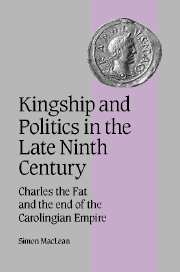 Kingship and Politics in the Late Ninth Century
Kingship and Politics in the Late Ninth Century Book contents
- Frontmatter
- Contents
- List of maps and figures
- Acknowledgements
- List of abbreviations
- Note on names, terminology and citations
- Outline chronology
- Figure 1 The Carolingian family
- Map 1 The late Carolingian empire
- 1 INTRODUCTION
- 2 UN-FRANKISH ACTIVITIES: CHARLES THE FAT IN THE EYES OF CONTEMPORARY ANNALISTS
- 3 THE MEN WHO WOULD BE KINGS: THE ‘SUPERMAGNATES’ AND THE ‘RISE OF THE ARISTOCRACY’
- 4 ROYAL POLITICS AND REGIONAL POWER IN THE LATE CAROLINGIAN EMPIRE
- 5 THE END OF THE EMPIRE I: POLITICS AND IDEOLOGY AT THE EAST FRANKISH COURT
- 6 THE END OF THE EMPIRE II: RESPONSE AND FAILURE
- 7 HISTORY, POLITICS AND THE END OF THE EMPIRE IN NOTKER'S DEEDS OF CHARLEMAGNE
- 8 CONCLUSION
- Bibliography
- Index
- Cambridge Studies in Medieval Life and Thought Fourth Series
6 - THE END OF THE EMPIRE II: RESPONSE AND FAILURE
Published online by Cambridge University Press: 15 July 2009
- Frontmatter
- Contents
- List of maps and figures
- Acknowledgements
- List of abbreviations
- Note on names, terminology and citations
- Outline chronology
- Figure 1 The Carolingian family
- Map 1 The late Carolingian empire
- 1 INTRODUCTION
- 2 UN-FRANKISH ACTIVITIES: CHARLES THE FAT IN THE EYES OF CONTEMPORARY ANNALISTS
- 3 THE MEN WHO WOULD BE KINGS: THE ‘SUPERMAGNATES’ AND THE ‘RISE OF THE ARISTOCRACY’
- 4 ROYAL POLITICS AND REGIONAL POWER IN THE LATE CAROLINGIAN EMPIRE
- 5 THE END OF THE EMPIRE I: POLITICS AND IDEOLOGY AT THE EAST FRANKISH COURT
- 6 THE END OF THE EMPIRE II: RESPONSE AND FAILURE
- 7 HISTORY, POLITICS AND THE END OF THE EMPIRE IN NOTKER'S DEEDS OF CHARLEMAGNE
- 8 CONCLUSION
- Bibliography
- Index
- Cambridge Studies in Medieval Life and Thought Fourth Series
Summary
CAROLINGIAN UNITY AND THE ADOPTION OF LOUIS OF PROVENCE, APRIL–JUNE 887
Hadrian III probably met his unexpected end in September 885 and, seemingly due to his unpopularity in Rome, was buried in the north Italian monastery of Nonantola rather than being taken back to the Holy See. His successor Stephen V was appointed quickly and without direct consultation with the emperor, whose attempt to have him deposed on this technicality failed because the election had taken place with the cooperation of the imperial legate in Rome. Charles was still preoccupied with the stalled plan to legitimate Bernard, who remained in the prayer clauses of imperial charters in 886 and early 887, and had doubtless hoped to influence the election to ensure that the new pontiff was sympathetic to its resuscitation. With Stephen's accession a fait accompli by the end of 885, the emperor had no choice but to travel to Italy at the start of 886 and negotiate with him directly. The specific outcome of the talks held during Charles's five- or six-month stay south of the Alps is not known beyond the fact that he extracted papal permission to translate bishops from devastated sees. However, our source for this information, the Bavarian annalist, cryptically adds that ‘many matters were arranged as he [Charles] wished’.
- Type
- Chapter
- Information
- Kingship and Politics in the Late Ninth CenturyCharles the Fat and the End of the Carolingian Empire, pp. 161 - 198Publisher: Cambridge University PressPrint publication year: 2003


